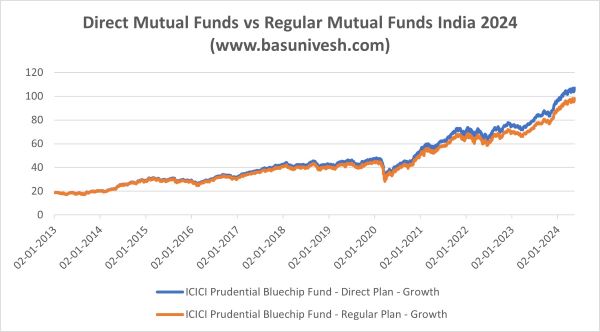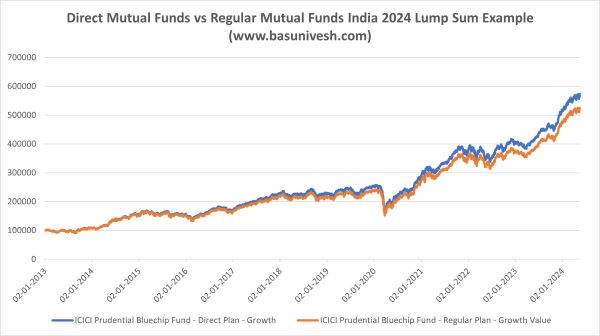With direct funds being launched practically 11 years in the past, it’s time to research Direct Mutual Funds vs Common Mutual Funds in India 2024.
It is not uncommon information that direct funds don’t contain middlemen, permitting traders to profit straight with decrease expense ratios. As an illustration, when evaluating the expense ratio of the ICICI Pru Bluechip Fund common plan at 1.49% to the direct plan at 0.9%, there’s a vital distinction of 0.59%. Though this proportion could seem small, it might make a considerable impression, notably for long-term traders.
The explanation I selected to characteristic ICICI Pru Bluechip Fund on this submit is because of its standing because the fund with the best AUM among the many oldest common funds. The oldest fund is the UTI Massive Cap Fund (37 years), adopted by the Franklin India Bluechip Fund (30 years). Nevertheless, when contemplating the oldest fund with the best AUM, ICICI Pru Bluechip Fund stands out. Subsequently, I’ve chosen this fund for my instance. Why give attention to the fund with the best AUM? I goal to reveal how even with a excessive AUM fund (the place the expense ratio will naturally lower on account of regulatory restrictions), the impression it might have is important when evaluating common and direct funds.
Direct Mutual Funds vs Common Mutual Funds in India 2024 – 11 Years Comparability
Allow us to fist evaluate the NAV motion of ICICI Pru Bluechip Fund direct vs common funds from 2013 to 2024.

It ought to be famous that the excellence just isn’t obvious for about 5-6 years. Subsequently, it turns into progressively noticeable after 5-6 years, and the disparity considerably will increase after a decade.
Assuming a person invested a lump sum quantity of Rs.1,00,000 on January 2nd, 2013, in each common and direct funds of ICICI Pru Bluechip Fund, what can be the ensuing variance in remaining worth?


The 2 graphs look the identical at first look, with no noticeable variations. Nevertheless, after we evaluate the share variance in returns between them, a transparent distinction emerges.
Therefore, allow us to evaluate the % distinction between direct vs common funds.


The distinction between direct and common funds is rising every year, with the present hole at round 8.3%. As bills additionally compound, this hole is anticipated to widen much more sooner or later.
The Web Asset Worth (NAV) of direct plans will proceed to outperform that of normal plans. This isn’t as a result of they’re dearer, however relatively as a result of direct plans have a decrease expense ratio, permitting their NAV to extend extra shortly. In consequence, the NAVs of direct plans are larger and can proceed to develop at a quicker charge in comparison with common plans. Though you’ll obtain fewer items when buying direct plans, the quickly growing NAV will result in improved returns and accelerated development of your portfolio.
Investing in direct funds could end in receiving fewer items in comparison with common funds because of the larger web asset worth (NAV). Nevertheless, it is very important be aware that the efficiency of the fund is what really issues, not the NAV. Subsequently, it’s advisable to keep away from the misunderstanding of solely searching for decrease NAV funds or new fund affords (NFOs).
Conclusion – I’m aiming to emphasise the distinction in returns between Direct Mutual Funds and Common Mutual Funds, do you have to determine to spend money on both one. Nevertheless, when you think about this distinction to be unimportant or when you worth the distributor’s position in managing your funds and subsequently want Common Mutual Funds, you might be welcome to proceed with that possibility. It’s essential to know that switching from Common to Direct Mutual Funds, even inside the similar fund, will end in taxes. Therefore, it’s important to make a deliberate choice based mostly in your private wants and preferences.
“Traders want to know not solely the magic of compounding long-term returns however the tyranny of compounding prices; prices that finally overwhelm that magic.”
? John C. Bogle, The Conflict of the Cultures: Funding vs. Hypothesis
